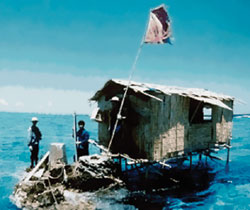What's new in exploration
A different kind of LMR. Rock properties such as compressibility, density, rigidity and type of porefluid can cause different responses to shear and compressional wave components. Goodway, et al., 1997, proposed a method (Lamda-Mu-Rho) to extract rock properties using Lamé’s constant (l, closely related to incompressibility), shear modulus (m), and density (r). The shear modulus conveys information about the rock exclusively, while l and r are affected by pore fluids as well. Dr. David Gray, a mathematician and researcher at Veritas, used AVO and inversion to extract these attributes from seismic data. Gray’s method is an unbiased, noise-reducing refinement of Goodway’s LMR method. It is applied to prestack seismic data to produce shear modulus and either Lamé’s modulus or bulk modulus volumes. The method uses the reflectivity of Lamé’s constant, the shear modulus reflectivity and density reflectivity. Special AVO analysis allows these reflectivities to be extracted from conventional, pre-stack, P-wave seismic data. These reflectivities are then inverted using post-stack amplitude inversion. Using these methods may prove superior to Poisson’s ratio and the Fluid Factor at distinguishing lithology from fluids. These methods allow a geoscientist to discriminate sand, shale, coal and carbonate from fluid effects using standard petrophysics. Gray’s refinement of the technique can reduce noise significantly over Goodway’s method, while at the same time removing the biases in Goodway’s approach caused by its mathematics and the density (r) term in Goodway’s lr and mr. The method allows assessment of the rock physics in a seismic section, discriminating sand, shale, coal and carbonate from fluid effects. Veritas recently made the processing and display technique commercially available. Goodway’s method, as described in an article by Gray, et al., is available in the July 2000 issue of World Oil, or at our website: www.worldoil.com. A complete discussion of Gray’s new method can be found at: www.veritasdgc.com/what/reservoir/frm_rockprop.htm. Useful government data. Two government data sources are available and have some new features that should be of interest to oil and gas professionals in the U.S. and UK. MMS, Gulf of Mexico OCS Region, is launching the Public Information Data System – an online system that allows customers to view and download various documents pertaining to the oil and gas industry. The documents include Well Summary Reports, Sundry Notices, Applications for Permit to Drill, Plans, Pipeline Rights-of-Way Files, and Suspensions of Production and Operations. The new system offers customers money and time savings, because the public can now get these documents through the Internet at any time. Each document comprises a set of TIFF images (soon to be PDF) that can be viewed and downloaded separately. There are nearly 1million images available, and they can be searched by using six different indexes, namely: Expired Leases, G&G Permits, Plans, Rights-of-Way, Suspensions of Production and Operations and Well Files. The system is available at: www.gomr.mms.gov. Cheaper data. The UK Onshore Geophysical Library (UKOGL) is offering new seismic data prices. UKOGL is the archive and official releasing body for seismic data recorded over land areas of the UK in cooperation with the Department of Trade and Industry and the UK Onshore Operators Group. The idea is to allow companies short-term access – at a greatly reduced cost – to the Library’s extensive collection of pre- and post-stack data during early stages of exploration. It wants to promote onshore licensing and exploration in the UK by helping companies to better assess these areas. Learning to share. The headline from the Chinese Ministry of Land and Natural Resources said that its “survey found 37-billion boe in Wan’an basin.” The region surveyed was northwest of the Spratly Islands in the South China Sea. The multi-year study “discovery” was, unfortunately, based on seismic and geological considerations, not the drillbit. Thus, nothing real was actually discovered.
The Ministry also said that the study showed “about 19 potential oil- and gas-bearing structures,” which ministry geologists estimate hold about “14.6 billion bbl of oil reserves and some 105.9 Tcf of natural gas reserves.” In all likelihood, they mean in situ oil and gas estimates, not reserves. Only four wells have been drilled in the region; three were dry and the last had gas shows. Nevertheless, the area is highly prospective. The lack of exploration drilling in Wan’an basin is due to unresolved disputes between the littoral nations surrounding the South China Sea, each of which claim large overlapping segments of the sea as their territory. China claims almost all of the South China Sea, including all of the Spratly Island region, which was estimated in 2000 to hold about 70.2 billion boe itself. The chain of small islets, reefs, and banks are claimed by China, Brunei, Malaysia, the Philippines, Taiwan and Vietnam. More than once, China and Vietnam have come close to war over them. Recently, China and the Association of South East Asian Nations (ASEAN) met in Phnom Penh and signed an accord to prevent conflict between themselves over the disputed waters of the South China Sea and especially the Spratly Islands. The agreement is an interim set of behavioral norms that should govern the parties pending the settlement of the jurisdictional and territorial questions.
|
|||||||||||
- Prices and governmental policies combine to stymie Canadian upstream growth (February 2024)
- U.S. producing gas wells increase despite low prices (February 2024)
- U.S. drilling: More of the same expected (February 2024)
- U.S. oil and natural gas production hits record highs (February 2024)
- Quantum computing and subsurface prediction (January 2024)
- U.S. upstream muddles along, with an eye toward 2024 (September 2023)





